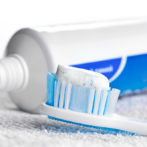Triclosan – Why It’s Being Banned And Which Brands Contain It!
You may have heard the news recently about Triclosan in toothpaste, and how some international bodies are moving to have it banned. In particular, the US Food Drugs and Alcohol body have banned the substance from all soap products. At this stage, however, they have left it in toothpaste. So what exactly is Triclosan – and why is it an issues? What is Triclosan, and why is it being banned? Triclosan is an antimicrobial substance that has been used in toothpaste, soaps, face wash, shower gel, and various other cosmetics and hygiene products for quite a while now. According the US FDA, the substance has shown a remarkable ability to reduce plaque and gingivitis. Unfortunately, recent animal studies have also shown that Triclosan may be an ‘endocrine disruptor’, meaning that it may lead to reproductive and developmental problems. Due to its anti-bacterial nature, Triclosan can also contribute to antibiotic resistance, which may have an impact on drug-resistant infections. Testing is, however, still at an early stage. For these reasons, Triclosan has been banned in soaps in the US, but not in toothpaste. The main difference behind this reasoning is that toothpaste is applied to a relatively small area, and isn’t consumed or kept in close contact with the skin. Which toothpastes contain it and should I be worried? Currently, Triclosan is not used in every toothpaste brand in Australia so, if you’re worried, you can easily avoid it. Brands like Sensodine are Triclosan free, for example. Many of the toothpastes we sell here at Robert Duhig Dentist are free of Triclosan – feel free to ask! Overall however, Australian dentists do not consider Triclosan a cause for concern at this stage. Studies have concluded that toothpastes using a combination of fluoride and Triclosan outperform those with just fluoride on multiple counts. When used for 6 months, the combination toothpastes reduced plaque by 41%, while gum inflammation was reduced by 22% and gum bleeding by 48%. This is significantly more than the toothpaste containing only fluoride. This makes Triclosan a really useful ingredient to consider if you have gingivitis or gum disease, though it arguably might be unnecessary in other circumstances. What is the nature of the current ban? The FDA didn’t actually conclude that Triclosan in soap was dangerous for human use. Instead, they suggest that some soap manufacturers had not submitted satisfactory safety evidence that their products were more effective than those without Triclosan. Closer to home, Australian federal body the National Industrial Chemicals Notification and Assessment Scheme (NICNAS) has conducted its own study and concluded that there is no concern for the public in regards to Triclosan at this time. You can read the findings of that...
Read More

